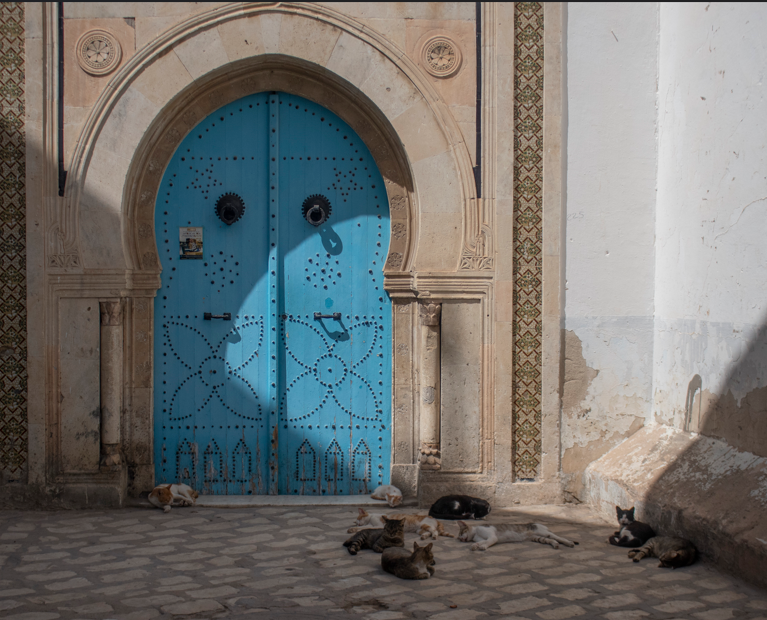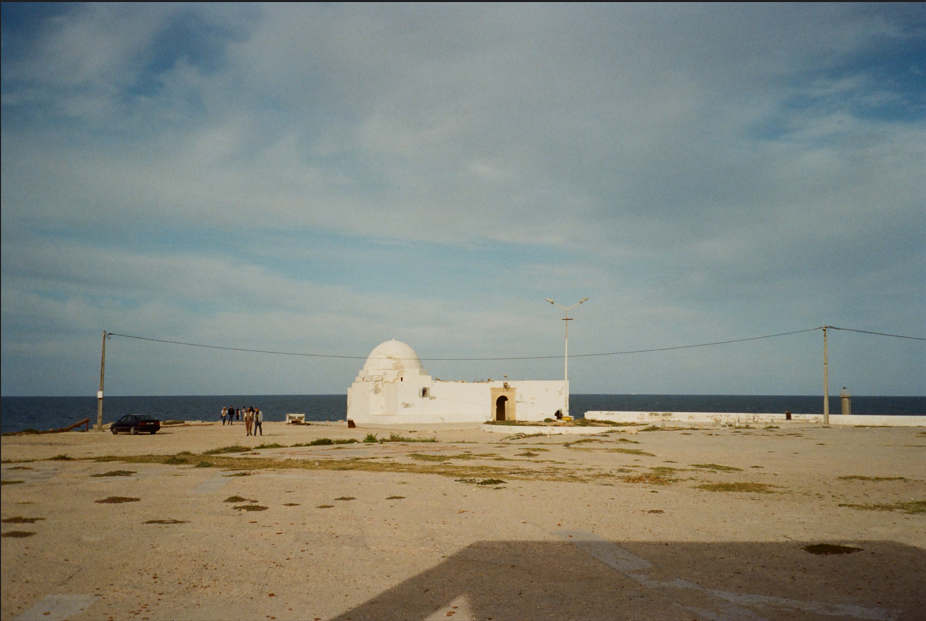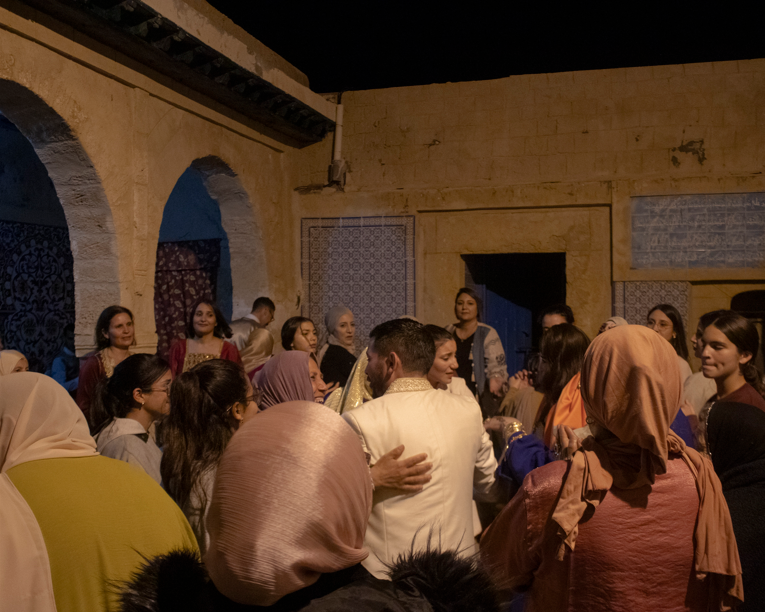"Remember(ing) Zawiyas" Student Exhibition at MacMillan Explores Sufi Sacred Spaces & Collective Memory in Tunisia
Sityana Abdu is a junior at Yale studying Global Affairs and Ethnography. Born and raised in Houston, Texas, and originally from Ethiopia, her work explores themes of belonging, nostalgia, and community, with a strong interest in archiving. She focuses on manifestations of Islam and culture, preserving and documenting these elements to create art that evokes a sense of something beyond oneself, and hopefully inspires change.
During her gap semester in Spring 2024, Sityana was awarded the Yale Thomas C. Barry Fellowship, which supported her travel to Tunisia to research zawiyas, buildings that serve as spiritual hubs for Sufi Islamic practice. Upon her return, the MacMillan Center supported a public exhibition of her poignant photography, now on display in the Luce Common Room at Luce Hall.
1. What inspired your trip to Tunisia, and why did you specifically focus on zawiyas?
My trip to Tunisia was a bit accidental. I was looking to go somewhere on the continent, and Professor Abdul-Rehman Malik at the Divinity School told me that interesting things were happening in Sousse at the New Medina and it could be a good academic and creative environment for me. Before getting there, I knew I wanted to focus on under-documented narratives in the Medina and I’ve always been interested in lived religion, but I didn’t yet know what form that would take.
The New Medina and their cofounder, Soraya Hosni, a Fall 2024 Yale World Fellow and current Research Fellow with the Council on Middle East Studies, invited me into her Tunisian community and provided a kind of access that made this research possible. They introduced me to Jessika Seekatz, who advised the research on a day-to-day basis, as well as my translators and community members who played a central role in shaping my understanding of the spaces I was documenting. Their approach to fieldwork and community engagement ensured that I was grounded in the local context, which helped me build trust, ask better questions, and make the most of my time in Sousse. I contributed to their Living Archives, an initiative dedicated to build an ethnographic and photographic archive on intangible heritage in Tunisia.
I arrived in Tunisia in March 2024 during Ramadan, right after completing Umrah, so I was in a reflective and spiritual headspace. I hadn’t lived anywhere like Tunisia, and it was extra special living in the Medina.
My research into zawiyas began serendipitously, and I’m grateful for that. Collective dhikr (sayings to remember Allah) were present and the white domes characteristic of zawiyas were everywhere in the city. I was instructed to just start knocking and was welcomed by this community of women who have dedicated their lives to maintaining these spaces. The more I learned, the more I wanted to know. The pursuit of knowledge is deeply encouraged in Islam and not just religious knowledge, but knowledge that helps us better understand the world and our place in it. I’m honored that I was drawn to this project and grateful for the chance to study something so rooted in Islamic tradition and history. It felt meaningful to explore these spaces not only as a researcher, but as someone personally connected to the faith.
2. In your exhibit, you highlight the role of women caretakers. How did gender influence your understanding of the culture and shape your research process?
Gender was a huge part of how I navigated and understood the Medina. Public religious spaces often felt male-dominated, and at first, I wasn’t excited about doing research that involved only male interlocutors. But once I connected with the women behind the zawiyas, I realized how much of the cultural and spiritual caretaking falls on their shoulders.
These women are the custodians of heritage. They don’t just maintain physical spaces; they keep traditions alive, hold knowledge, and pass it down through generations. Seeing how central they are to the continuity of culture completely reshaped how I thought about preservation, memory, and sacred space.
3. How significant was it for you that the exhibition is displayed at the MacMillan Center?
The MacMillan Center provided both the financial and intellectual support that made this work possible. As a hub for area and international studies, it felt like the right place to host an exhibit that intersects questions of gender, religion, and preservation.
Tunisia is also underrepresented in both global conversations and academic discourse, especially here at Yale. So, this exhibit felt like a way to open up that space and share the lives and stories of people who are often left out of larger narratives about Islam, heritage, and Africa.
5. As someone with Ethiopian heritage, why was it important for you to explore religious and cultural practices in another African country? What insights did you gain from this experience?
I was honestly a bit worried about how to navigate my role as a non-Tunisian in these spaces. In my social sciences classes, I’ve learned a lot about how damaging Western researchers can be when working with so-called “native” communities. I knew I was entering an unfamiliar place and that I needed to approach it with humility, respect, and a willingness to listen, observe, and learn.
Ethnography is rooted in relationship-building, and I tried to approach that process with care. There were small but meaningful choices I made, like not photographing people’s faces, not bringing my camera into zawiyas until the women were comfortable with me, and participating in Sufi rituals. These actions helped establish trust. From the beginning, I also involved Tunisians closely in the project. Having the New Medina serve as my community liaison was essential. Their involvement helped ensure that people were comfortable with my presence and open to speaking with me. In addition to Hosni, who advised and supported the work, my translators and close friends Malek Sallemi and Nassar Elhedhli were vital collaborators. They acted as cultural bridges throughout the process and helped guide the research in ethical and respectful ways.
The Tunisians I met constantly reminded me that I had a home there, and over time, I truly began to feel that. Even now, when I meet Tunisians and tell them I lived in Sousse, their response is always so warm. I miss the food, the music, the people, and the dialect. I’m proud of the community I built in Sousse.
This experience also deepened my appreciation for how Islam can serve as a unifying and placemaking force across borders and cultures. Being Ethiopian-American didn’t make me any less capable of doing this work. If anything, it gave me a unique lens through which to learn, connect, and contribute.
In addition to the MacMillan Center, Abdu's research and exhibition was also supported by the Thomas C. Barry Fellowship and Muslim Leadership Lab.


